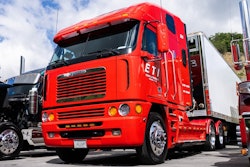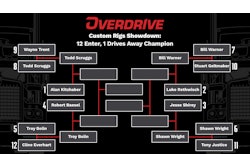Preventive maintenance is a wonderful thing. Most of the time it’s close enough to foolproof that you can rely on it to keep you out of serious trouble on the road. But in winter, close enough isn’t good enough.
Sometimes fleet drivers depend entirely too much upon preventive maintenance schedules and shop mechanics to keep their trucks in shape while those who own their trucks, or drive their trucks as if they owned them, create a substantially safer environment for themselves – particularly in winter.
Winter safety means avoiding potentially dangerous situations rather than trying to cowboy your way through them. That process often begins with choosing a company with a policy that allows drivers to make informed decisions about their delivery schedules when weather forces unexpected delays. Think ahead: will you be able to use your own judgment when dispatch expects you to roll? Remember when you choose your company that many of the same people who expect you to roll out into the snow will ask you why you decided to take the chance if you call them from a ditch.
“I will not put my truck in jeopardy for a load of freight,” owner-operator Grant Sheldon says. “My customers know this. They also know that if I am late, it is for a good reason. I stop when the weather gets too bad.”

Fleet drivers with good reputations with their dispatchers can afford to adopt the same attitude. A good reputation can save your life.
Weather-related accidents are not the only surprises winter has in store. Any mechanical problem a driver faces is made more difficult by harsh weather and it doesn’t take snow and ice to make life miserable. A bright blue sky in winter can signal extremely cold temperatures that will make any breakdown more painful if not more hazardous, so prepare before you’re there. Water leaks and low coolant levels are best found in the truckstop parking lot rather than on the super slab. Tire problems easily fixed in the morning before moving out become major headaches if they surface on the road.
Perhaps the most significant single thing a driver can do during his pretrip is to pull the chain or crack the petcocks on his air tanks. Although desiccant, the drying agent in air dryers, has improved significantly in recent years, authorities from experienced drivers like Sheldon to fleet managers like Lou Markowitz at Crete Carrier say this simple act can nip air line freezing in the bud.
Knowing your limits when driving in winter weather can save your life.
“A lot of moisture in air systems when a driver pulls the chain on his air tanks means the desiccant in the dryer is used up and it is time to service the dryer. I check mine once a week,” Sheldon says. Markowitz adds, “It doesn’t hurt to pull your air valve cord every day in winter just to be safe.” This will minimize or eradicate completely air line freeze ups. In the event of a problem, a driver can carry pure alcohol to pour into his glad hand connections. But take care. According to Chuck Blake, application engineer at Detroit Diesel, “Some alcohol bought off the shelf contains as much as 30 percent water.” Given this fact, draining air tanks may well be a better alternative to alcohol during pretrip procedures
If you drive long enough in winter weather, you’re bound to experience a frozen brake sooner or later. Many drivers will carry a few tools to deal with these types of problems. When it comes to frozen brakes, the tool to use is a hammer. Sheldon does not advocate the use of torches to free frozen brakes: “Torches can do more harm than good,” he says.
The fleet driver often is better served by a phone call to get road service than a personal effort, which may get him rolling but may be contrary to company policy. Tyler Polich, service writer at Barr Nunn Transportation in Grainger, Iowa, says the company short circuits as many winter problems as possible with preventive maintenance and prewinter preparation. “We put a fuel additive in our trucks to kill algae once a year. Our trucks return engine-warmed fuel to the tanks to help prevent waxing and gelling. If the temperature drops below 10 degrees we will allow a driver to use an additive. We don’t put anything in the air lines but if there is a problem the driver can buy an off-the-shelf product formulated for air line freeze ups.” Barr Nunn’s drivers are taught to check in their mirrors, in particular the passenger side mirror, for dragging trailer wheels, Polich said.
Drivers for large fleets can generally rely upon company-mandated maintenance schedules to keep fuel filters fresh. Those who drive for smaller fleets may want to keep track of preventive maintenance schedules on their vehicle to ensure fuel filters are changed before their usefulness is overcome by waxed or gelled fuel. Large fleets often provide a fuel filter but will not provide a filter wrench. Buy a wrench that is the proper size for the filter on your truck. Not every wrench fits every filter. Changing a filter is much easier than cracking injectors. But having a fresh filter and a wrench will do absolutely no good unless you are carrying a jug of fuel to pour into the filter and draw fuel out of the tank.
Smart drivers will keep their tanks full as well, because it cuts down on the buildup of water condensation. It’s a move that will also provide the added benefit of increased fuel mileage. Fuel mileage drops considerably when the tank is below one quarter full. Drivers working in large fleets probably run in fuel systems, making the probability of getting bad fuel negligible. Small fleet drivers can cut this possibility by buying fuel at chains or at the same stops as much as possible.
In cold weather, fuel can wax or gel. Waxing will start in No. 2 diesel fuel at about 15 degrees. It will cause the fuel to look cloudy and the wax that is in all petroleum products will begin to form crystals that can eventually clog elbows, valves and filters. Be aware of temperature and wind chill. Fuel gels at about 17 degrees below zero. Fuel can even gel in a running truck when it’s cold enough. Wind chill hitting fuel lines and elbows speeds up the gelling process, and at 65 miles per hour there is considerable wind chill on a winter’s day. At the same time you can idle in a lot and be awakened by the sensation of the truck shutting down. Strong wind drops the temperature quickly and can turn your 300 gallons of fuel to silly putty while you’re snoring.
Traction also is a big concern during icy weather. At Crete, fleet managers encourage their drivers to buy a bag or two of kitty litter. According to Markowitz, “Kitty litter and a good entrenching tool will get you out of most slick spots. We tell our drivers to put kitty litter under the wheels, put it in third and ease on out.”
Self-protection is still the name of the game if you are a professional driver. Large fleets often come down on the side of safety and allow drivers the latitude to make decisions about when to shut it down in bad weather. Remember that your truck and load is not the same as the guy’s next to you who has decided to give it a try right after the troopers open the big road. He may have enough weight to give traction while your empty trailer will make the road seem slicker. Don’t be fooled by a desire to prove your manhood and ignore common sense safety.
Smart Winter Driving Tips
- Drive to stay out of trouble. Increase following distances. Don’t get into situations from which there is no escape.
- Carry chains and know how to install them.
- In hazardous weather, the effects of fatigue are more quickly felt. Be aware of your personal limitations and how they are stretched by the stress of winter driving.
- Carry a milk crate with an extra fuel filter, pure alcohol, the proper filter wrench, a hammer, some kitty litter, an army shovel and a gallon of fuel.
- Carry a survival kit with warm work clothes and some food that is not perishable.
- If you don’t have one, consider the purchase of a cell phone. They are indispensable during emergencies and breakdowns.
- Listen to the weather in the morning before starting out. Plan accordingly. Have at least one device onboard that can help you keep checking the weather as the day progresses.
- Know your company’s policy about additives, tools, breakdowns and driver discretion. Know your braking system. If you are running full ABS, the best method of braking is to hit the brakes and hold the pressure. But remember that locked brakes means your wheels have no traction.
- When you drive a new EGR engine, remember turbo sounds that once denoted drive tire slippage will be different or inaudible. Make sure you remember this when you crawl behind the wheel of your first EGR-powered horse.








